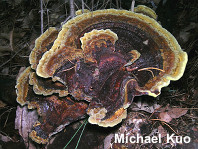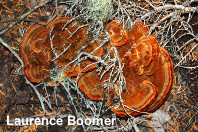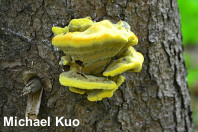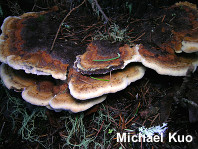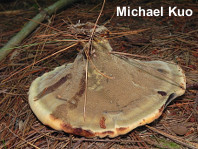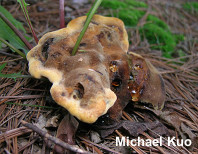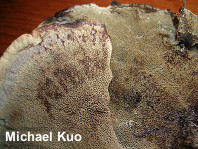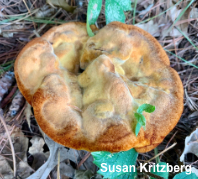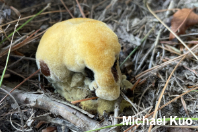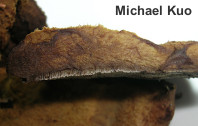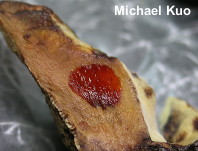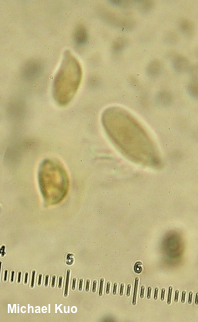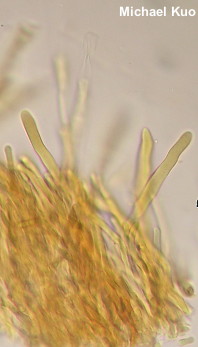| Major Groups > Polypores > Phaeolus schweinitzii |

|
Phaeolus schweinitzii [ Basidiomycota > Polyporales > Laetiporaceae > Phaeolus . . . ] by Michael Kuo This mushroom is a classic "butt rot" fungus, attacking trees through their roots and producing decay in the root system and the heartwood of the lower portion of the tree (up to about 10 or 20 feet above ground). The result is a weakened, or even hollow, tree base—which makes the tree more susceptible to windthrow, especially if other agents (beetles, for example) have combined destructive forces with the fungus. Phaeolus schweinitzii is partial to conifers, and is usually found near the base of the tree's trunk, appearing terrestrial. It has a velvety, brown to olive cap and, when young, a strikingly yellow or orange, brown-bruising pore surface and margin. The pores are angular and fairly large, and the fairly thin, flexible flesh is brown to reddish brown. With age the mushroom's colors are more boring and brown, but the pore surface usually retains a greenish hue. Microscopic features (see below) are distinctive. Old specimens of Phaeolus schweinitzii can cause confusion, since they are often no longer velvety and lack any hints of the interesting yellow and orange shades they displayed in their youth. Even the pore surface turns entirely brown, and no longer bruises. Phaeolus schweinitzii should be compared to Onnia tomentosa, which can look similar but lacks the bright yellow or orange colors in young stages and, under the microscope, features abundant setae. Thanks to Laurence Boomer and Susan Kritzberg for collecting, documenting, and preserving Phaeolus schweinitzii for study; their collections are deposited in The Herbarium of Michael Kuo. Description: Ecology: Parasitic on the roots and heartwood of living conifers and saprobic on deadwood; causing a brown to reddish brown cubical rot; annual; "especially common in old-growth timber with basal fire scars" (Gilbertson & Ryvarden, 1987); originally described from Sweden; widely distributed in Europe, North America, Central America, Asia, and Oceania. In the United States, common on Douglas-fir in the West, white pine in eastern North America, and loblolly pine in the South. The illustrated and described collections are from California, Illinois, Michigan, Oregon, and Pennsylvania. Fruiting Body: Usually with one to several loosely arranged, large lobes arising from a single stem-like structure that emerges from the ground—but occasionally in fused, shelving brackets attached to the base of the tree. Cap: 7–30 cm across; more or less circular, semicircular, or broadly lobed in outline (more circular when terrestrial and more semicircular when on standing wood), flat or centrally depressed; dry; roughened; velvety, especially when young and along the margin, but sometimes becoming bald in old age; with concentric zones of color and texture; colors extremely variable, ranging from dark brown to rusty brown or olive brown, with zones of yellow and/or olive, and a paler marginal zone which can be very bright yellow or orange when young; paler, velvety zones often bruising promptly brown. Pore Surface: Running down the stem; orange to bright yellow when young, becoming greenish yellow to olive, and eventually brown; bruising promptly dark brown to nearly black; with 1–3 angular or almost slot-like pores per mm; tubes 1–7 mm deep. Stem: Usually present as a more or less central structure; 2.5–5 cm long; 2–2.5 cm thick; brown and velvety below the pore surface; bruising darker brown. Flesh: Pale brown becoming rusty brown; fairly soft when young, becoming stringy and leathery; often appearing zoned. Odor: Sweetly fragrant, or not distinctive. Chemical Reactions: KOH black on flesh and cap surface, often with a cherry red intermediate stage (especially with younger specimens). Spore Print: Reported as whitish to yellowish. Microscopic Features: Spores 6–12 x 3–5 µm; ellipsoid to elongated-amygdaliform; smooth; hyaline to yellowish in KOH; inamyloid. Setae absent. Hymenial cystidia 40–100 x 5–12.5 µm; cylindric with rounded to subclavate apices; thin-walled; smooth; hyaline to brownish in KOH. Hyphal system monomitic; contextual hyphae thin- to moderately thick-walled, simple-septate, occasionally branching, reddish brown in KOH, 3–15 µm wide. Tissues usually leach yellow to orangish pigments in KOH mounts. REFERENCES: (E. M. Fries, 1821) N. T. Patouillard, 1900. (Overholts, 1953; Phillips, 1981; Smith, Smith & Weber, 1981; Arora, 1986; Breitenbach & Kränzlin, 1986; Gilbertson & Ryvarden, 1987; States, 1990; Phillips, 1991/2005; Lincoff, 1992; Metzler & Metzler, 1992; Barron, 1999; Roody, 2003; McNeil, 2006; Miller & Miller, 2006; Trudell & Ammirati, 2009; Buczacki et al., 2013; Kuo & Methven, 2014; Desjardin, Wood & Stevens, 2015; Evenson, 2015; Siegel & Schwarz, 2016; Gminder & Böhning, 2017; Woehrel & Light, 2017; Baroni, 2018; Elliott & Stephenson, 2019; Læssøe & Petersen, 2019; Sturgeon, 2019; Kibby, 2020; McKnight et al., 2021.) Herb. Kuo 01120611, 08250602, 09060803, 10231301, 07221413, 08241405, 09011608, 09012102. This site contains no information about the edibility or toxicity of mushrooms. |
© MushroomExpert.Com |
|
Cite this page as: Kuo, M. (2022, February). Phaeolus schweinitzii. Retrieved from the MushroomExpert.Com Web site: http://www.mushroomexpert.com/phaeolus_schweinitzii.html |
